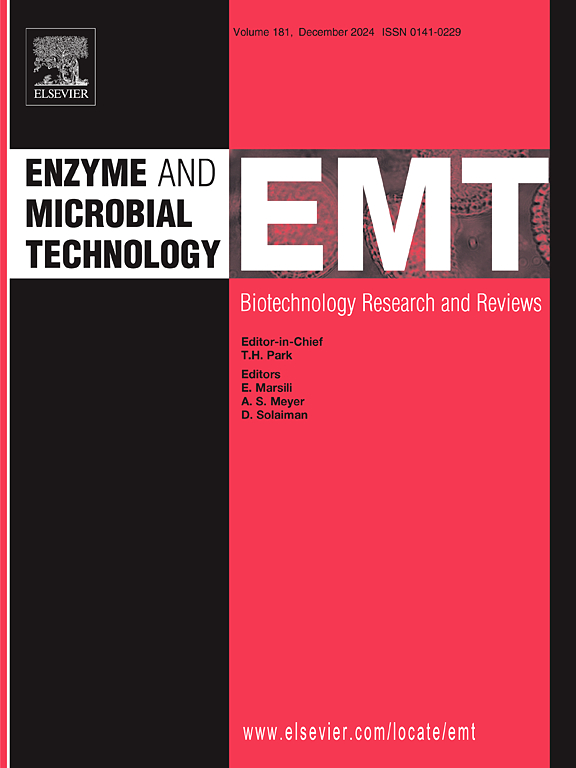Biodegradation of crude oil by newly enriched biosurfactant-producing bacterial consortium
IF 3.7
3区 生物学
Q2 BIOTECHNOLOGY & APPLIED MICROBIOLOGY
引用次数: 0
Abstract
Crude oil contamination in different environmental media is a global environmental problem, biodegradation is a potential, environmentally friendly method for remediating this pollutant. In the present study, a biosurfactant-producing and crude oil degrading bacterial consortium (S1) was enriched from a contaminated soil, and its degradation efficiency of crude oil in solution and soil under the optimum conditions was studied. The results showed that the predominant species of S1 were Pseudomonadaceae and Alcaligenaceae. S1 could produce surfactant, with the maximum content of 2.27 g/L, which was identified as rhamnolipids. The optimal pH, temperature, and (NH4)2SO4 concentration for crude oil degradation were 7.0, 40 °C, and 3 g/L, respectively, with the maximum degradation efficiency of 51.51 % after 7 days incubation. Plackett-Burman experiment and response surface methodology demonstrated that Cu, Co, and Zn could significantly promote the degradation of crude oil, with their optimum concentration of 0.36, 0.88, and 0.60 mg/L, respectively. Under the optimum conditions, the highest crude oil degradation efficiency reached 53.23 % within 7 days. Kinetic analysis showed that the first-order reaction kinetic was suitable for describing the degradation of crude oil by S1, with a half-life of 4.57 days. Furthermore, S1 also could degrade the crude oil in soil efficiently, with the maximum degradation efficiency of 60.34 % within 56 days. These results indicate that S1 has great potential for practical application in remediation of crude oil contamination.
新富集的产生物表面活性剂菌群对原油的生物降解
原油在不同环境介质中的污染是一个全球性的环境问题,生物降解是一种潜在的、环境友好的方法来修复这种污染物。本研究从污染土壤中富集了一种产表面活性剂和原油降解菌群(S1),研究了其在最佳条件下对溶液和土壤中原油的降解效果。结果表明,S1的优势种为假单胞菌科和藻藻科。S1可产生表面活性剂,最大含量为2.27 g/L,经鉴定为鼠李糖脂。原油降解的最佳pH、温度和(NH4)2SO4浓度分别为7.0℃、40℃和3 g/L,培养7 d后,最大降解率为51.51 %。Plackett-Burman实验和响应面法表明,Cu、Co和Zn对原油的降解有显著的促进作用,其最佳浓度分别为0.36、0.88和0.60 mg/L。在最优条件下,7 d内原油降解率最高可达53.23 %。动力学分析表明,一级反应动力学适合描述S1对原油的降解,半衰期为4.57 d。S1对土壤中的原油也有较好的降解能力,56 d内的最大降解效率为60.34 %。这些结果表明,S1在原油污染修复中具有很大的实际应用潜力。
本文章由计算机程序翻译,如有差异,请以英文原文为准。
求助全文
约1分钟内获得全文
求助全文
来源期刊

Enzyme and Microbial Technology
生物-生物工程与应用微生物
CiteScore
7.60
自引率
5.90%
发文量
142
审稿时长
38 days
期刊介绍:
Enzyme and Microbial Technology is an international, peer-reviewed journal publishing original research and reviews, of biotechnological significance and novelty, on basic and applied aspects of the science and technology of processes involving the use of enzymes, micro-organisms, animal cells and plant cells.
We especially encourage submissions on:
Biocatalysis and the use of Directed Evolution in Synthetic Biology and Biotechnology
Biotechnological Production of New Bioactive Molecules, Biomaterials, Biopharmaceuticals, and Biofuels
New Imaging Techniques and Biosensors, especially as applicable to Healthcare and Systems Biology
New Biotechnological Approaches in Genomics, Proteomics and Metabolomics
Metabolic Engineering, Biomolecular Engineering and Nanobiotechnology
Manuscripts which report isolation, purification, immobilization or utilization of organisms or enzymes which are already well-described in the literature are not suitable for publication in EMT, unless their primary purpose is to report significant new findings or approaches which are of broad biotechnological importance. Similarly, manuscripts which report optimization studies on well-established processes are inappropriate. EMT does not accept papers dealing with mathematical modeling unless they report significant, new experimental data.
 求助内容:
求助内容: 应助结果提醒方式:
应助结果提醒方式:


